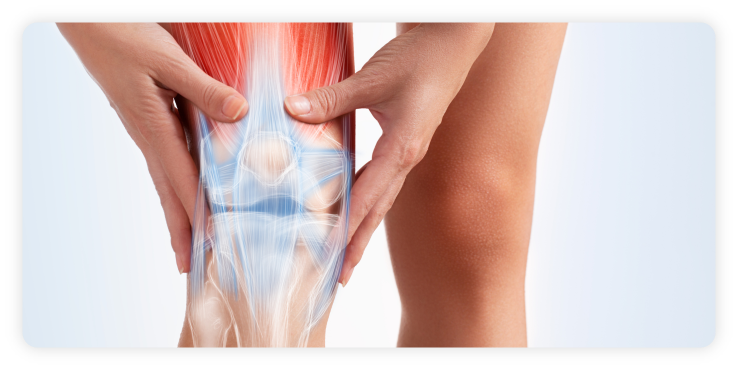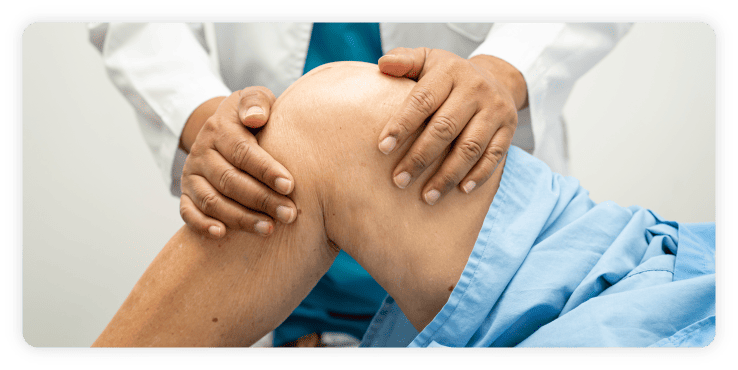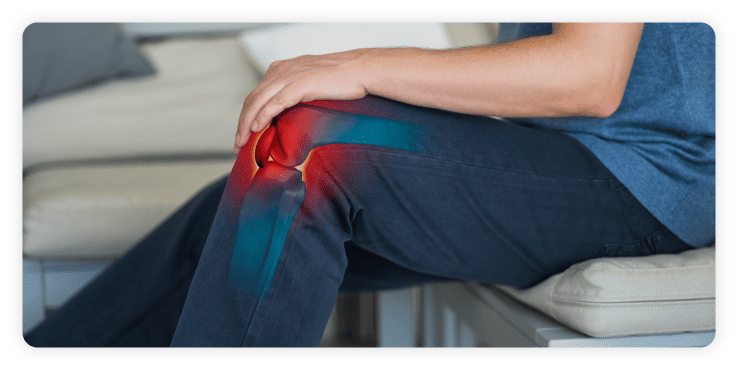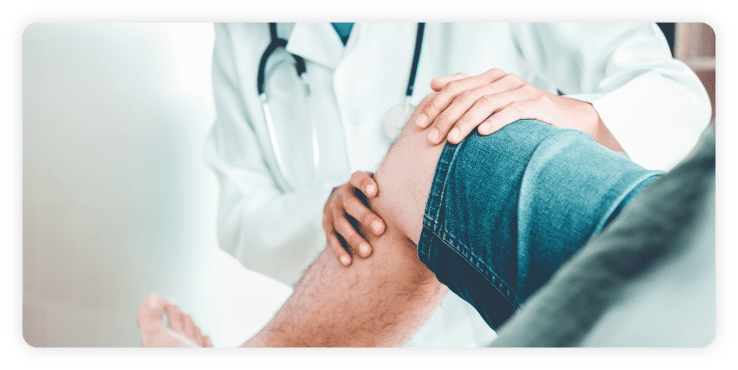Chronic Headaches: Possible Causes And Treatments
What is a Headache? Headaches are one of the most frequent complaints. Narrowly defined, a headache is a pain in the head or face, and sometimes also includes pain in…

Knee pain is more than just an uncomfortable inconvenience—it can seriously impact your daily activities and overall quality of life. Whether it’s a dull ache, sharp pain, or persistent stiffness, knee pain should not be ignored. Early identification of the causes of knee pain is crucial to prevent it from worsening and leading to long-term damage. Delaying treatment can result in chronic pain, reduced mobility, and even permanent joint damage.
There are many reasons for knee pain, ranging from injuries like ligament tears or meniscus damage to conditions such as osteoarthritis or patellar tendinitis. Overuse, poor posture, or even weight gain can add strain on the knee joint, worsening symptoms over time. Identifying the specific causes of knee pain is key to determining the right treatment plan and preventing further complications.

Ignoring knee pain can lead to long-term consequences, such as joint instability or an increased risk of injury to surrounding muscles and ligaments. Seeking early intervention not only provides relief but also promotes better long-term outcomes. Specialised treatments can help restore mobility, reduce inflammation, and address underlying issues.
At Orchard Health Clinic, our knee pain specialists are experienced in diagnosing and treating all forms of knee pain. Whether you’re dealing with an acute injury or chronic discomfort, we can provide a tailored treatment plan.
Don’t let knee pain hold you back. Addressing the issue early with the right treatment can help you maintain an active, pain-free lifestyle.

Knee pain can sometimes be more than just a result of strain or overuse. It could be a sign of underlying medical conditions that require immediate attention.
The causes of knee pain can range from simple injuries to more serious, degenerative issues or infections. It’s important to understand these potential conditions, as they can lead to chronic pain or further complications if left untreated. Here are some common reasons for knee pain:
Degenerative Conditions
Tendon and Joint Issues
Inflammatory Conditions
Serious Health Concerns
If you’re unsure about the causes of your knee pain or how to treat your condition, it’s best to consult with a specialist. Contact us to get the correct diagnosis and effective knee pain treatment. Identifying the underlying condition early can help prevent further damage and provide the appropriate solutions for pain relief and recovery.

Chronic knee pain doesn’t resolve on its own, and if left untreated, it can lead to long-term mobility issues, making it more challenging to perform everyday activities. Fortunately, the condition is treatable, and the appropriate course of treatment depends on the underlying cause of knee pain. Here are some of the possible causes and implications of chronic knee pain, as well as treatment options that can help alleviate the discomfort:
Chronic knee pain can result from a variety of conditions, including degenerative issues like osteoarthritis, injuries such as ligament tears, or overuse. Identifying the reasons for knee pain is crucial for determining the most effective knee pain treatment. Some causes might include:
Chronic knee pain can affect your ability to perform daily activities, including walking, climbing stairs, or even standing for long periods. Knee pain treatment is necessary to improve joint mobility, restore strength, and help you regain function. The longer the pain persists, the more it can limit your lifestyle and negatively impact your quality of life.
Without treatment, chronic knee pain can worsen over time, leading to further joint deterioration. Conditions like osteoarthritis can progressively damage the knee joint, resulting in decreased range of motion and stiffness. If left untreated, the pain can become more severe, leading to difficulty moving and performing even basic tasks.
Chronic knee pain may cause you to alter the way you move, putting additional strain on other parts of your body, such as the hips, back, or opposite leg. This compensation can result in further injuries. For example, pain at the back of the knee might lead you to shift your weight forward, causing discomfort and strain in the hips or lower back.
Addressing chronic knee pain early on can help avoid further complications and improve your overall well-being. If you are unsure about the cause of your knee pain, contact our specialists at Orchard Health Clinic to discuss potential solutions customised to your needs.

There are several treatment options available for managing knee pain, depending on the cause and severity of the condition. Regardless of the type of knee pain that you are suffering from, understanding your options is key to finding the right solution. Here are the primary treatment methods for knee pain, covering both non-invasive approaches and medical procedures.
Physical therapy and osteopathy are some of the most common and effective non-invasive treatments for knee pain, especially when it comes to patella pain. It focuses on strengthening the muscles around the knee, improving flexibility, and reducing strain on the joint. Knee pain treatment through physical therapy may involve specific exercises aimed at improving the alignment of the knee and restoring joint mobility. An osteopath can also work with you to create a personalised plan, using techniques to improve movement and relieve discomfort.
Chiropractic care is another non-invasive option that helps relieve knee pain by addressing the misalignment of the joints and muscles. Chiropractors focus on realigning the spine and other joints, which can help improve overall movement patterns and reduce knee pain. Chiropractic adjustments can be particularly helpful for meniscus pain and other types of knee pain caused by musculoskeletal imbalances. Chiropractic treatment may also include stretches and lifestyle advice to avoid further discomfort.
For more persistent or severe knee pain, especially when the causes of knee pain include arthritis or damaged tissues, medical procedures may be necessary. Corticosteroid injections can reduce inflammation and provide temporary pain relief. Hyaluronic acid injections may help restore lubrication in the joint, easing movement and reducing discomfort. In cases of significant cartilage damage or knee meniscus pain, surgical procedures, such as meniscus repair or knee replacement, may be recommended. These treatments are typically considered when non-invasive methods have not been effective.
Adopting healthier lifestyle habits and modifying your activities can significantly reduce knee pain over time. Regular low-impact exercises, like swimming or cycling, can help maintain joint mobility and reduce stiffness while also improving overall knee strength. Avoiding high-impact activities, like running on hard surfaces or jumping, can prevent further strain on the knees. Wearing supportive footwear and using orthotics can help redistribute weight and alleviate pressure on the knee joints.
Sometimes, simply resting the knee and applying ice to the affected area can provide relief from pain and inflammation. Ice therapy helps reduce swelling and numb the area, making it easier to manage knee pain in the short term. Resting the knee and avoiding activities that aggravate the pain is crucial for allowing the tissues to heal. Ice packs can be applied for 15 to 20 minutes several times a day for maximum benefit, especially in the acute stages of knee pain treatment.
By addressing the reasons for knee pain early and seeking the appropriate treatment, you can manage the condition effectively and reduce the risk of long-term complications. If you are experiencing knee pain or patella pain, contact our specialists to discuss your treatment options and get personalised care tailored to your needs.
While most knee pain can be managed with non-invasive treatments, there are rare cases where surgery is required. When knee pain becomes chronic and severely affects mobility, surgical options like knee surgery, knee replacement, or knee arthroscopy may be necessary. These procedures are typically considered when other treatments have not provided relief and the knee joint is significantly damaged.
Knee arthroscopy is a minimally invasive procedure used to diagnose and treat various knee conditions. It involves inserting a small camera (arthroscope) into the knee joint through small incisions.
This allows surgeons to view the inside of the knee and treat problems such as meniscal tears or ligament injuries. Knee arthroscopy is typically performed as a day surgery, and most patients can go home the same day or the next. The recovery time is relatively short, and physical therapy may be prescribed to regain strength and mobility.
For patients with severe arthritis or extensive damage to the knee joint, knee replacement surgery may be recommended. This surgery involves resurfacing the damaged joint with metal and plastic prostheses. It is commonly performed for tri-compartmental arthritis, where all three parts of the knee are affected.
Although knee replacement can significantly improve quality of life and relieve pain, it is considered a major surgery. Post-operative care includes physical therapy, pain management, and avoiding high-impact activities.
After knee surgery, rehabilitation is crucial to ensuring a successful recovery. Post-operative care may involve wearing a knee brace, following a guided exercise program to improve joint mobility, and reducing swelling. Knee surgery rehab usually includes physical therapy to strengthen the muscles around the knee and improve flexibility.
Recovery time varies depending on the procedure, with knee replacement surgery typically requiring a longer recovery period compared to arthroscopy. Patients are often encouraged to begin light weight-bearing activities shortly after surgery, with full mobility returning over several weeks or months.
If you are uncertain about whether surgery is the right option for your knee pain, it is essential to consult with a specialist who can guide you through your choices.
Read More
What is a Headache? Headaches are one of the most frequent complaints. Narrowly defined, a headache is a pain in the head or face, and sometimes also includes pain in…
Signs That Indicate You Need To Visit A Chiropractor Pain is the body’s way of telling us that something is wrong. Sometimes, homemade treatments can be sufficient to alleviate the pain.…
PART 1 – INTRODUCTION Health and well-being are paramount concerns for those seeking a balanced and fulfilling life. However, in our fast-paced modern world, our hectic lives can cause us…
Follow Us
CONTACT US
BUSINESS HOURS
© Copyright 2024, Orchard Health Clinic. All Rights Reserved.